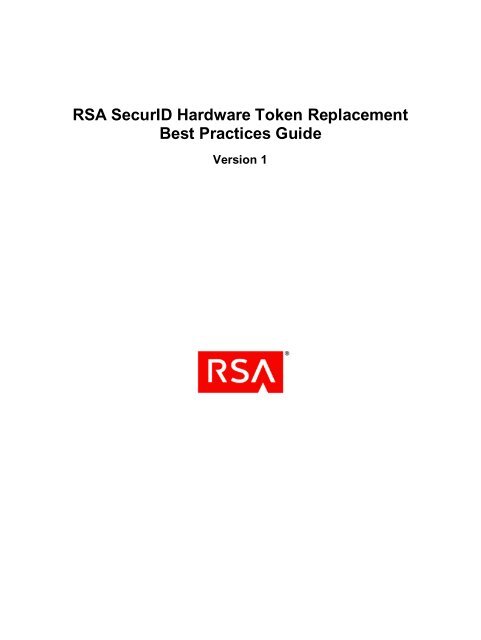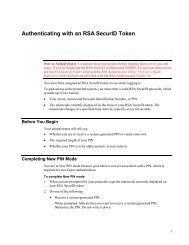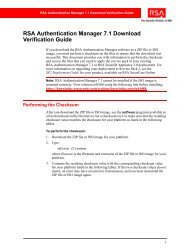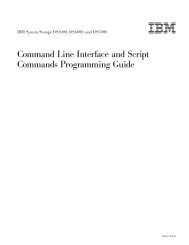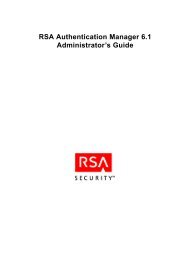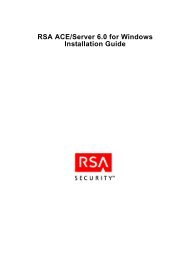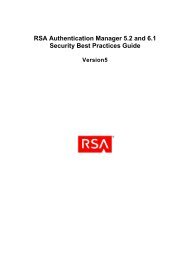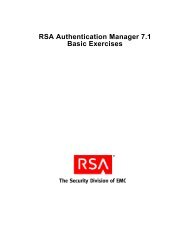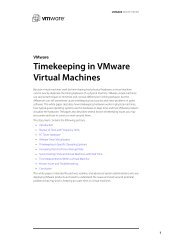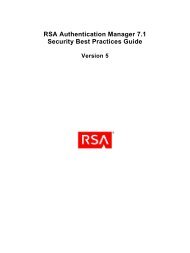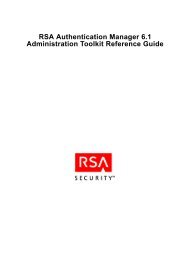RSA SecurID Hardware Token Replacement Best Practices Guide
RSA SecurID Hardware Token Replacement Best Practices Guide
RSA SecurID Hardware Token Replacement Best Practices Guide
Create successful ePaper yourself
Turn your PDF publications into a flip-book with our unique Google optimized e-Paper software.
<strong>RSA</strong> <strong>SecurID</strong> <strong>Hardware</strong> <strong>Token</strong> <strong>Replacement</strong><br />
<strong>Best</strong> <strong>Practices</strong> <strong>Guide</strong><br />
Version 1
Contact Information<br />
Go to the <strong>RSA</strong> corporate web site for regional Customer Support telephone and fax numbers: www.rsa.com.<br />
Trademarks<br />
<strong>RSA</strong>, the <strong>RSA</strong> Logo and EMC are either registered trademarks or trademarks of EMC Corporation (“EMC”) in the United<br />
States and/or other countries. All other trademarks used herein are the property of their respective owners. For a list of <strong>RSA</strong><br />
trademarks, go to www.rsa.com/legal/trademarks_list.pdf.<br />
License Agreement<br />
The white paper and any part thereof is proprietary and confidential to EMC and is provided only for internal use by<br />
licensee. Licensee may make copies only in accordance with such use and with the inclusion of the copyright notice below.<br />
The white paper and any copies thereof may not be provided or otherwise made available to any other person.<br />
No title to or ownership of the white paper or any intellectual property rights thereto is hereby transferred. Any unauthorized<br />
use or reproduction of the guide may be subject to civil and/or criminal liability.<br />
The white paper is subject to update without notice and should not be construed as a commitment by EMC.<br />
Note on Encryption Technologies<br />
The referenced product may contain encryption technology. Many countries prohibit or restrict the use, import, or export of<br />
encryption technologies, and current use, import, and export regulations should be followed when using, importing or<br />
exporting the referenced product.<br />
Distribution<br />
Use, copying, and distribution of any EMC software described in this publication requires an applicable software license.<br />
Disclaimer<br />
EMC does not make any commitment with respect to the software outside of the applicable license agreement.<br />
EMC believes the information in this publication is accurate as of its publication date. EMC disclaims any obligation to<br />
update after the date hereof. The information is subject to update without notice.<br />
THE INFORMATION IN THIS PUBLICATION IS PROVIDED TO SUGGEST BEST PRACTICES, IS PROVIDED "AS<br />
IS," AND SHALL NOT BE CONSIDERED PRODUCT DOCUMENTATION OR SPECIFICATIONS UNDER THE<br />
TERMS OF ANY LICENSE OR SIMILAR AGREEMENT. EMC CORPORATION MAKES NO REPRESENTATIONS<br />
OR WARRANTIES OF ANY KIND WITH RESPECT TO THE INFORMATION IN THIS PUBLICATION, AND<br />
SPECIFICALLY DISCLAIMS IMPLIED WARRANTIES OF MERCHANTABILITY OR FITNESS FOR A<br />
PARTICULAR PURPOSE.<br />
All references to “EMC” shall mean EMC and its direct and indirect wholly-owned subsidiaries, including<br />
<strong>RSA</strong> Security LLC.<br />
Copyright © 2011 EMC Corporation. All Rights Reserved.<br />
November 2011
<strong>RSA</strong> <strong>SecurID</strong> <strong>Hardware</strong> <strong>Token</strong> <strong>Replacement</strong> <strong>Best</strong> <strong>Practices</strong> <strong>Guide</strong><br />
Critical Sections<br />
Planning Considerations: Page 3<br />
<strong>RSA</strong> <strong>SecurID</strong> <strong>Token</strong> <strong>Replacement</strong> Approach: Page 7<br />
Testing: Page 9<br />
Restrictions and Limitations: Page 10<br />
Introduction<br />
This guide contains additional guidance for customers pursuing hardware token replacement. This<br />
guidance focuses on the planning and implementation approach for replacing a customer’s existing<br />
<strong>RSA</strong> <strong>SecurID</strong> hardware tokens with new <strong>RSA</strong> <strong>SecurID</strong> hardware tokens in the customer’s<br />
environment.<br />
This guide is applicable to customer <strong>RSA</strong> <strong>SecurID</strong> implementations of all sizes using <strong>RSA</strong><br />
Authentication Manager 5.2, 6.1 or 7.1. However, the replacement procedures are generally intended<br />
for customers with relatively small user populations. Customers with large user populations may<br />
require additional tools and assistance, which is available through <strong>RSA</strong> Professional Services. If you<br />
have this type of user population, contact your <strong>RSA</strong> Account Manager for information about <strong>RSA</strong><br />
Professional Services.<br />
Note: This guide does not include guidance on conversion from <strong>RSA</strong> <strong>SecurID</strong> hardware tokens to<br />
<strong>RSA</strong> <strong>SecurID</strong> software tokens. Customers with this requirement should contact their <strong>RSA</strong> Account<br />
Manager about using <strong>RSA</strong> Professional Service in a separate services engagement.<br />
Planning Considerations<br />
<strong>RSA</strong> strongly recommends that you carefully plan and test your token replacement strategy before<br />
rolling it out within a production <strong>RSA</strong> <strong>SecurID</strong> environment due to the potential impacts on end-users<br />
and the potential to undermine the security posture of the overall system.<br />
This planning should include a phased token distribution approach. This may include a prioritization<br />
of targeted user populations and location of users, as well as communications to end-users to notify<br />
them of the plan and to tell them what to expect.<br />
For a small number of token replacements, <strong>RSA</strong> recommends that you use the Authentication<br />
Manager administrative interface to replace tokens one at a time. However, to replace large numbers<br />
of hardware tokens, <strong>RSA</strong> recommends that you use bulk administration tools or scripts. When<br />
assigning replacement tokens, <strong>RSA</strong> recommends that the current PIN be maintained on the<br />
replacement token so that the token is not placed in New PIN mode. This simplifies the activation of<br />
the new token for the end-user.<br />
3
<strong>RSA</strong> <strong>SecurID</strong> <strong>Hardware</strong> <strong>Token</strong> <strong>Replacement</strong> <strong>Best</strong> <strong>Practices</strong> <strong>Guide</strong><br />
<strong>RSA</strong> strongly recommends that you strengthen your PIN policy, but that you do so under a separate<br />
initiative or engagement that does not overlap with the replacement of a user’s token. This is less<br />
intrusive and less confusing for your end-users.<br />
Note: When replacing tokens, a new token can be associated with an existing token for a user. A<br />
token can be assigned for replacement days or weeks before a user actually receives the token, at<br />
which point they are instructed to, upon their next authentication, use their existing PIN followed by<br />
the tokencode from the new replacement token. Once the user is successfully authenticated with the<br />
new token, the old token will be automatically unassigned from their account and the new<br />
replacement token activated.<br />
For information about PIN policy best practices, see the <strong>RSA</strong> Authentication Manager Security<br />
<strong>Best</strong> <strong>Practices</strong> <strong>Guide</strong>.<br />
Consider the following when planning your <strong>RSA</strong> <strong>SecurID</strong> hardware token replacement:<br />
1. Thoroughly review the target <strong>RSA</strong> <strong>SecurID</strong> environment to ensure a good understanding of<br />
the scope of the token replacement project, as well as possible tools required to complete the<br />
tasks.<br />
If the environment has a documented architecture, as well as documented processes (such as<br />
for user enrollments, token renewals / replacements, etc.), use this as the basis of the review.<br />
If not, the current method for managing end-user tokens (new or replacement) should be well<br />
understood and leveraged to minimize the impact on your environment and end-users.<br />
2. Determine which users in the environment require token replacement. Many environments<br />
have multiple token types, but the approach in this guide is for hardware tokens only. The<br />
Authentication Manager reporting tools or scripts can help identify these users.<br />
3. Determining which users should receive hardware token replacements will likely be subject to<br />
a variety of policy and other business requirements and should therefore be carefully planned<br />
out. <strong>RSA</strong> recommends that users with the most privileges, especially those responsible for<br />
administering the Authentication Manager environment or other sensitive systems, be given<br />
highest priority.<br />
It may also be desirable or necessary to further split users into manageable groups especially<br />
if tokens are typically distributed regionally.<br />
Use the following table to assist with the creation of a prioritized token replacement strategy:<br />
4
<strong>RSA</strong> <strong>SecurID</strong> <strong>Hardware</strong> <strong>Token</strong> <strong>Replacement</strong> <strong>Best</strong> <strong>Practices</strong> <strong>Guide</strong><br />
User Grouping<br />
<strong>RSA</strong> Admins<br />
User<br />
Classification<br />
High Privilege<br />
Notes<br />
<strong>RSA</strong> Authentication Manager system administrators with<br />
the permissions for system configuration, token<br />
distribution, and so on. In Authentication Manager 6.1<br />
these are users assigned one or more administrative<br />
“Task Lists”; in Authentication Manager 7.1 these are<br />
users assigned at least one “Administrative Role”.<br />
Users with some ability to manage tokens or users, but<br />
restricted in some fashion from broader access, for<br />
example, help desk personnel<br />
Users with administrative permissions to <strong>RSA</strong> agent<br />
protected infrastructure, such as servers, firewalls,<br />
switches, VPN concentrators, and so on, but not <strong>RSA</strong><br />
Authentication Manager administrators<br />
<strong>RSA</strong> <strong>Token</strong> Users<br />
External Admins<br />
Agent Protected<br />
Application<br />
Consumers<br />
Privileged<br />
Privileged<br />
Special<br />
Users with access to restricted agents or groups most<br />
likely users accessing enterprise applications, such as<br />
PCI systems, HR, and so on.<br />
<strong>Token</strong> End-Users<br />
Standard<br />
Users that use tokens to authenticate to unrestricted<br />
applications or for infrastructure access. These users<br />
have no special permissions in <strong>RSA</strong> Authentication<br />
Manager or other systems other than being required to<br />
use tokens for authentication.<br />
Note: This table is a general guideline only. You may need to establish other prioritization<br />
criteria in accordance with your organization’s business requirements, existing policies and<br />
procedures, communication plans or mechanisms and any applicable legal, regulatory and/or<br />
compliance regimes.<br />
4. Determine the best <strong>RSA</strong> <strong>SecurID</strong> hardware token distribution mechanism. Factors that may<br />
affect this decision are:<br />
• Current distribution methods – Leveraging a current distribution method, which is<br />
familiar within an environment, is generally easier to implement and can often avoid<br />
confusion.<br />
• The security of the current distribution method – Ensuring that the proper <strong>RSA</strong> <strong>SecurID</strong><br />
token is distributed to the proper user.<br />
• Location of end-users - Determine whether users are in a single office location or remote<br />
offices.<br />
If tokens must be shipped to remote locations and offices, be careful to use accurate shipping<br />
addresses to ensure the correct token is delivered to the correct user at the most secure<br />
location possible.<br />
5
<strong>RSA</strong> <strong>SecurID</strong> <strong>Hardware</strong> <strong>Token</strong> <strong>Replacement</strong> <strong>Best</strong> <strong>Practices</strong> <strong>Guide</strong><br />
5. Your replacement plan must also take into consideration the number of hardware tokens to be<br />
replaced. Organizations with large numbers of tokens to be replaced may not have the<br />
capacity to store or distribute all tokens in a single phase. In these situations a phased<br />
approach and roll out plan may need to be developed.<br />
6. A communication plan, particularly in large environments, is necessary to inform end-users of<br />
the replacement plan and how it will be implemented. This helps to set the correct<br />
expectations regarding process and timelines. Every organization has its own employee<br />
communications mechanism and standards which should be utilized.<br />
It is especially important to inform the end-users of how to activate their new tokens when<br />
they receive them and the need for them to do so as soon as possible. You should also give<br />
guidance to end-users to protect against social engineering or other ways in which fraudsters<br />
may attempt to subvert or co-opt the process. Advise end-users to alert the proper authorities<br />
of any suspicious behavior. Combining such messaging reinforces the importance of the endusers’<br />
role in the process. For guidance on preventing social engineering attacks, see the<br />
<strong>RSA</strong> Authentication Manager Security <strong>Best</strong> <strong>Practices</strong> <strong>Guide</strong>.<br />
7. Once the token replacement process is initiated, you should have a plan to:<br />
• Track the progress of the tokens being replaced. If there is too much time between the<br />
delivery of a new token and the activation of the token, then you should contact end-users<br />
to ensure replacements have not fallen into the wrong hands. Proper reporting and<br />
auditing procedures should be established to assist with managing the process without<br />
over complicating it. Proper and clear communication of end-user expectations and<br />
responsibilities, as described above, can help ensure the process goes as smoothly and<br />
quickly as possible.<br />
• Remove the old token from the Authentication Manager database once a new token has<br />
been successfully activated and the old token is unassigned.<br />
• Dispose of old tokens. Provide guidance to end-users on what to do with their old tokens<br />
once the new ones are activated. Ideally, an organization will have a token disposal<br />
procedure in place already. If not, however, consideration should be given to creating one<br />
and communicating the details to the end-users stressing the importance of proper<br />
disposal.<br />
The following link is <strong>RSA</strong>’s statement on disposal of <strong>RSA</strong> <strong>SecurID</strong> tokens which can be<br />
incorporated as part of the customer overall disposal plan:<br />
http://www.rsa.com/support/pdfs/<strong>Token</strong>_Disposal_statement.pdf<br />
6
<strong>RSA</strong> <strong>SecurID</strong> <strong>Hardware</strong> <strong>Token</strong> <strong>Replacement</strong> <strong>Best</strong> <strong>Practices</strong> <strong>Guide</strong><br />
<strong>RSA</strong> <strong>SecurID</strong> <strong>Token</strong> <strong>Replacement</strong> Approach<br />
<strong>SecurID</strong> <strong>Token</strong> <strong>Replacement</strong> Using Administrative Interface<br />
As mentioned earlier in this document, for a relatively low number of token replacements, <strong>RSA</strong><br />
recommends that you use the Authentication Manager administrative interface to replace tokens one<br />
at a time. This is the high-level process for token replacement for Authentication Manager 7.1, 6.1<br />
and 5.2 using the administrative interface:<br />
1. Logon to the Authentication Manager administrative interface:<br />
• For Authentication Manager 6.1 and 5.2 this is through Quick Admin or the Remote<br />
Desktop Client.<br />
• For Authentication Manager 7.1 this is through the Security Console.<br />
2. Import new seed records into the Authentication Manager Primary server.<br />
3. Look up the specific user whose token you want to replace and identify the current token<br />
assigned to that user.<br />
4. Note the assigned <strong>RSA</strong> <strong>SecurID</strong> token, and proceed to edit the currently assigned <strong>RSA</strong><br />
<strong>SecurID</strong> <strong>Token</strong> to associate a new replacement <strong>RSA</strong> <strong>SecurID</strong> <strong>Token</strong>. This functionality<br />
permits the automated replacement through a user initiated authentication.<br />
5. Repeat for every user that requires a replacement <strong>RSA</strong> <strong>SecurID</strong> <strong>Token</strong>.<br />
6. Validate in the Authentication Manager administrative interface that the operations were<br />
successful.<br />
7. Create a report of users with their assigned replacement tokens for distribution purposes.<br />
8. Execute your communication plan to inform users and to set expectations.<br />
9. Distribute tokens to the correct users in a secure manner that is convenient for the<br />
organization.<br />
10. Users perform an authentication (login) to an <strong>RSA</strong> agent using the newly assigned token. The<br />
Login is performed with normal passcode (current PIN + tokencode from new token).<br />
7
<strong>RSA</strong> <strong>SecurID</strong> <strong>Hardware</strong> <strong>Token</strong> <strong>Replacement</strong> <strong>Best</strong> <strong>Practices</strong> <strong>Guide</strong><br />
11. The original token is replaced by a new (replacement) token.<br />
• Original token is unassigned from user.<br />
• Original token may be deleted from database simultaneously.<br />
• Same PIN is maintained on the replacement token.<br />
Note: For information about PIN policy best practices, see the <strong>RSA</strong> Authentication<br />
Manager Security <strong>Best</strong> <strong>Practices</strong> <strong>Guide</strong>.<br />
12. Run reports on regular intervals to ensure token replacements occur within days of receipt. If<br />
token replacements are taking too long, disable the user’s account or existing token forcing<br />
them to contact an administrator or appropriate help desk personnel.<br />
Detailed steps for token replacement for Authentication Manager 7.1 5.2 and 6.1 can be found in<br />
Appendix A and Appendix B respectively.<br />
<strong>RSA</strong> <strong>SecurID</strong> <strong>Token</strong> <strong>Replacement</strong> Using Bulk Scripting<br />
When replacing large numbers of hardware tokens, <strong>RSA</strong> recommends that you use bulk<br />
administration tools or scripts. This is the high-level process for token replacement for Authentication<br />
Manager 7.1, 6.1 and 5.2 using scripts:<br />
1. Import new seed records into the Authentication Manager Primary server.<br />
2. Install the appropriate scripts on the Authentication Manager primary server.<br />
3. Use the reporting capabilities of each platform to identify users and physical tokens that must<br />
be replaced at each location.<br />
4. Generate a list of token serial numbers and associated users for which tokens are being<br />
replaced in accordance with your token replacement strategy.<br />
5. Generate a list of replacement token serial numbers (attempt to group by box/tray of tokens to<br />
facilitate distribution).<br />
6. Create a coma separated values (.csv) input file for the associate scripts in the required<br />
format.<br />
7. Run scripts to replace tokens for list of users.<br />
Note: You should test the scripts and input files in a test environment to make sure they<br />
achieve the desired results.<br />
8. Manually validate in the Authentication Manager administrative interface that the operation<br />
was successful.<br />
9. Destroy copies of the .csv files and Excel files used to create the replacement loader file.<br />
10. Create a report of users with their assigned replacement tokens for distribution purposes.<br />
11. Execute your communication plan to inform users and to set expectations.<br />
8
<strong>RSA</strong> <strong>SecurID</strong> <strong>Hardware</strong> <strong>Token</strong> <strong>Replacement</strong> <strong>Best</strong> <strong>Practices</strong> <strong>Guide</strong><br />
12. Distribute tokens to the correct users in a secure manner that is convenient for the<br />
organization.<br />
13. User performs an authentication (login) to an <strong>RSA</strong> agent using the newly assigned token; the<br />
Login is performed with normal passcode (current PIN + tokencode from new token).<br />
14. The original token is replaced by a new (replacement) token.<br />
• Original token is unassigned from user.<br />
• Original token may be deleted from database simultaneously.<br />
• Same PIN is maintained on the replacement token.<br />
Note: For information about PIN policy best practices, see the <strong>RSA</strong> Authentication<br />
Manager Security <strong>Best</strong> <strong>Practices</strong> <strong>Guide</strong>.<br />
15. Run reports on regular intervals to ensure token replacements occur within days of receipt. If<br />
token replacements are taking too long, disable the user’s account or existing token forcing<br />
them to contact an administrator or appropriate help desk personnel.<br />
16. Destroy all copies of the CSV files, Excel files, and user and token lists used for the token<br />
replacement activity.<br />
The token replacement scripts will vary slightly depending if the customer’s environment is<br />
Authentication Manager 7.1 or Authentication Manager 6.1 (and prior). Detailed steps for token<br />
replacement on Authentication Manager 7.1, 6.1 and 5.2 using scripts can be found at Appendix C<br />
and Appendix D respectively.<br />
For more information about bulk administration tools, contact your Sales Representative.<br />
Testing<br />
The following are essential test considerations:<br />
• <strong>Token</strong>s and seed records utilized in the test environment should not be re-used in production<br />
after the testing phase.<br />
• Scripts and tools, if utilized, for performing bulk operations should always be tested in a<br />
development or test environment which replicates the production environment as much as<br />
possible.<br />
• When applying the token replacement solution to the production environment, apply to a<br />
smaller group of pilot users before applying to the larger user population.<br />
• Testing should include scenarios for at least the following tasks:<br />
• End-user token activation procedure(s).<br />
• If utilized, testing the token import scripts and input files.<br />
• Validating scripts for generating user and token assignment reports.<br />
9
<strong>RSA</strong> <strong>SecurID</strong> <strong>Hardware</strong> <strong>Token</strong> <strong>Replacement</strong> <strong>Best</strong> <strong>Practices</strong> <strong>Guide</strong><br />
Restrictions and Limitations<br />
All guidance and information set forth in this white paper and any other documents, including,<br />
without limitation, guidance and other information published in the <strong>Best</strong> <strong>Practices</strong> <strong>Guide</strong>s, regarding<br />
the creation of a phased and prioritized hardware token replacement strategy is general guidance and<br />
is provided “as is” and EMC makes no representations or warranties of any kind with respect to the<br />
information in this white paper and specifically disclaims implied warranties of merchantability or<br />
fitness for a particular purpose.<br />
<strong>RSA</strong> strongly recommends that each organization’s actual plan be established in accordance with its<br />
business requirements, existing policies and procedures, communication plans or mechanisms and any<br />
applicable regulatory compliance regimes.<br />
10
<strong>RSA</strong> <strong>SecurID</strong> <strong>Hardware</strong> <strong>Token</strong> <strong>Replacement</strong> <strong>Best</strong> <strong>Practices</strong> <strong>Guide</strong><br />
Appendix A: <strong>RSA</strong> Authentication Manager 7.1 <strong>Token</strong> <strong>Replacement</strong><br />
Using Security Console<br />
Overview<br />
This appendix describes the process for replacing hardware tokens in Authentication Manager 7.1.<br />
The “Replace <strong>SecurID</strong> <strong>Token</strong>” functionality is designed for replacing an existing hardware token with<br />
a new token where the end-user’s PIN is retained.<br />
To activate a replacement token, the end-user must authenticate with the new token at which point the<br />
Authentication Manager server unassigns and disables or deletes the old token from the database and<br />
assigns the existing PIN to the new token.<br />
Using the “Replace <strong>SecurID</strong> <strong>Token</strong>” option is the recommended method for issuing new tokens to<br />
users due to the superior end-user experience while also reducing administrative activity, such as<br />
assigning end-users new tokens and manually disabling the old token. Software or hardware tokens<br />
can be used to replace existing software or hardware tokens in the system. This guidance is for<br />
replacing <strong>RSA</strong> <strong>SecurID</strong> hardware tokens with new <strong>RSA</strong> <strong>SecurID</strong> hardware tokens only.<br />
There are two separate options when using “Replace <strong>SecurID</strong> <strong>Token</strong>”:<br />
• replacing a token by manually selecting a specific token from a list of available tokens; or<br />
• replacing a token with the next available token from the pool of available tokens.<br />
The “next available” replacement process is only suitable for customers with a limited number of<br />
tokens distributed from a central location since the automatic selection process randomly selects the<br />
next unassigned token with the lowest serial number.<br />
For hardware tokens this requires the exact token to be located and retrieved from the correct tray of<br />
tokens. It may also have the additional effect of assigning a different <strong>RSA</strong> <strong>SecurID</strong> token type, for<br />
example, an <strong>RSA</strong> <strong>SecurID</strong> Software <strong>Token</strong>, which may not be the desired result. <strong>RSA</strong> recommends<br />
the manual selection option described below.<br />
<strong>Token</strong> <strong>Replacement</strong> Process – Manually Selected <strong>Token</strong><br />
The following instructions describe how to assign a replacement token from a searchable list of<br />
available, unassigned tokens. It is best suited for assigning replacement hardware “fob” tokens,<br />
especially if tokens are issued or shipped from multiple locations, or where software and hardware<br />
tokens are deployed.<br />
This process affords the best control over assigning replacements so the administrator can make the<br />
appropriate choice based on their business and/or logistical requirements.<br />
11
<strong>RSA</strong> <strong>SecurID</strong> <strong>Hardware</strong> <strong>Token</strong> <strong>Replacement</strong> <strong>Best</strong> <strong>Practices</strong> <strong>Guide</strong><br />
To replace an <strong>RSA</strong> <strong>SecurID</strong> hardware token with a selected <strong>RSA</strong> <strong>SecurID</strong> hardware token:<br />
1. Log on to the <strong>RSA</strong> Security Console.<br />
2. Lookup the user and then token. Click Identity > Users > Manage Existing.<br />
3. Select the correct Identity Source.<br />
Figure 1- User Lookup<br />
Figure 2- Select Identity Source<br />
4. By default the UI searches on last name. Optionally pick a different user attribute from the list<br />
if desired. For example, you can pick User ID.<br />
Figure 3- User Search Attribute Screen<br />
12
<strong>RSA</strong> <strong>SecurID</strong> <strong>Hardware</strong> <strong>Token</strong> <strong>Replacement</strong> <strong>Best</strong> <strong>Practices</strong> <strong>Guide</strong><br />
5. Enter identifying user information in the search box and execute the search for the user.<br />
Figure 4- User Search<br />
6. Click the menu icon next to the UserID and select <strong>SecurID</strong> <strong>Token</strong>s from the menu.<br />
Figure 5- User Context Menu<br />
13
<strong>RSA</strong> <strong>SecurID</strong> <strong>Hardware</strong> <strong>Token</strong> <strong>Replacement</strong> <strong>Best</strong> <strong>Practices</strong> <strong>Guide</strong><br />
7. The tokens assigned to the user will be listed.<br />
Figure 6- List of tokens assigned to user<br />
8. Make note of the token serial number to be replaced.<br />
Figure 7 - Making Note of the token serial number<br />
14
<strong>RSA</strong> <strong>SecurID</strong> <strong>Hardware</strong> <strong>Token</strong> <strong>Replacement</strong> <strong>Best</strong> <strong>Practices</strong> <strong>Guide</strong><br />
9. Click Authentication > <strong>SecurID</strong> <strong>Token</strong>s > Manage Existing.<br />
Figure 8- Manage Existing <strong>RSA</strong> <strong>SecurID</strong> <strong>Token</strong>s<br />
10. Enter the recorded serial number, and if necessary, select the correct security domain from the<br />
drop-down list and click Search.<br />
11. Select the token to be replaced<br />
Figure 9- Search for Chosen <strong>Token</strong> to be a <strong>Replacement</strong><br />
Figure 10- Select the <strong>Token</strong> to Be Replaced<br />
15
<strong>RSA</strong> <strong>SecurID</strong> <strong>Hardware</strong> <strong>Token</strong> <strong>Replacement</strong> <strong>Best</strong> <strong>Practices</strong> <strong>Guide</strong><br />
12. From the Action menu, select Replace <strong>SecurID</strong> <strong>Token</strong>s, and click Go.<br />
Figure 11- Select Replace <strong>SecurID</strong> <strong>Token</strong>s From Action Menu<br />
13. Select an <strong>RSA</strong> <strong>SecurID</strong> hardware token from the tray and enter the serial number in the<br />
search dialog.<br />
Figure 12- Enter Serial Number of New <strong>Token</strong><br />
16
<strong>RSA</strong> <strong>SecurID</strong> <strong>Hardware</strong> <strong>Token</strong> <strong>Replacement</strong> <strong>Best</strong> <strong>Practices</strong> <strong>Guide</strong><br />
14. Select the token and click Next.<br />
Figure 13- Select the Chosen <strong>Replacement</strong> <strong>Token</strong><br />
17
<strong>RSA</strong> <strong>SecurID</strong> <strong>Hardware</strong> <strong>Token</strong> <strong>Replacement</strong> <strong>Best</strong> <strong>Practices</strong> <strong>Guide</strong><br />
15. Click Save & Finish to complete the hardware token replacement.<br />
Figure 14- Confirm the <strong>Replacement</strong><br />
16. The selected hardware token has now been activated as a replacement.<br />
Figure 15- <strong>Hardware</strong> <strong>Token</strong> as <strong>Replacement</strong> Complete<br />
This is the end of the hardware token replacement process. You must repeat this process for each<br />
token that is being replaced.<br />
18
<strong>RSA</strong> <strong>SecurID</strong> <strong>Hardware</strong> <strong>Token</strong> <strong>Replacement</strong> <strong>Best</strong> <strong>Practices</strong> <strong>Guide</strong><br />
Appendix B: <strong>RSA</strong> Authentication Manager 5.2 and 6.1 <strong>Token</strong><br />
<strong>Replacement</strong> Using Administrative Interface<br />
Overview<br />
This document describes the manual process for replacing hardware tokens in Authentication<br />
Manager 5.2 and6.1. The “Assign <strong>Replacement</strong> <strong>Token</strong>” functionality is designed for replacing an<br />
existing token with a new token where the user’s PIN is retained. To activate a replacement token, the<br />
end-user must authenticate with the new token. After a successful authentication, Authentication<br />
Manager unassigns and disables or deletes the old token from the database, and assigns the existing<br />
PIN to the new token.<br />
Using the “Assign <strong>Replacement</strong> <strong>Token</strong>” option is the recommended method for issuing new tokens to<br />
users due to the superior end-user experience while also reducing administrative activity, such as<br />
assigning users new tokens and manually disabling the old token. Software or hardware tokens can be<br />
used to replace existing software or hardware tokens in the system. This guidance is for replacing<br />
hardware tokens with new hardware tokens only.<br />
<strong>Token</strong> <strong>Replacement</strong> Process – Manually Selected <strong>Token</strong><br />
To replace an <strong>RSA</strong> <strong>SecurID</strong> hardware token with a selected <strong>RSA</strong> <strong>SecurID</strong> <strong>Hardware</strong> token:<br />
1. Log on to Authentication Manager through Quick Admin or the Database Administration<br />
application in remote mode.<br />
2. Click System Configuration > System Parameters > <strong>Token</strong>, PIN and Password<br />
Parameters. If not already selected, select Automatically delete replaced tokens from<br />
database. Selecting this option completely removes the replaced token from the database<br />
after a successful authentication with the replacement token.<br />
19
<strong>RSA</strong> <strong>SecurID</strong> <strong>Hardware</strong> <strong>Token</strong> <strong>Replacement</strong> <strong>Best</strong> <strong>Practices</strong> <strong>Guide</strong><br />
Figure 16- Enable Automatic Delete of Replaced <strong>Token</strong> Screen<br />
3. Lookup user and then token. Click User > Edit User.<br />
Figure 17- User Lookup<br />
4. Select a user. You can search for a user by First name, Last name or Default Login (UserID).<br />
20
<strong>RSA</strong> <strong>SecurID</strong> <strong>Hardware</strong> <strong>Token</strong> <strong>Replacement</strong> <strong>Best</strong> <strong>Practices</strong> <strong>Guide</strong><br />
Figure 18- User Search Page<br />
21
<strong>RSA</strong> <strong>SecurID</strong> <strong>Hardware</strong> <strong>Token</strong> <strong>Replacement</strong> <strong>Best</strong> <strong>Practices</strong> <strong>Guide</strong><br />
5. Once the user is selected, a page displays with the user’s information. This page contains<br />
information about the user’s current token and administrative actions that can be performed<br />
against the token.<br />
6. Click Edit Assigned <strong>Token</strong>.<br />
Figure 19- User <strong>Token</strong> Information Page<br />
Figure 20- Edit Assigned <strong>Token</strong> Option<br />
22
<strong>RSA</strong> <strong>SecurID</strong> <strong>Hardware</strong> <strong>Token</strong> <strong>Replacement</strong> <strong>Best</strong> <strong>Practices</strong> <strong>Guide</strong><br />
7. Click Assign <strong>Replacement</strong> <strong>Token</strong>.<br />
Figure 21- Assign <strong>Replacement</strong> <strong>Token</strong> Screen<br />
8. Enter replacement token serial number or click <strong>Token</strong>s to list available tokens. Ensure Retain<br />
PINs from token to be replaced is selected.<br />
Figure 22- Entering <strong>Token</strong> Serial number on ‘Select <strong>Replacement</strong> <strong>Token</strong>’ Screen<br />
23
<strong>RSA</strong> <strong>SecurID</strong> <strong>Hardware</strong> <strong>Token</strong> <strong>Replacement</strong> <strong>Best</strong> <strong>Practices</strong> <strong>Guide</strong><br />
Figure 23- Listing Available <strong>Token</strong>s on ‘Select <strong>Replacement</strong> <strong>Token</strong>’ Screen<br />
9. The screen will display information about the token and additional actions that can be<br />
performed against the token. It will also list the replacement token information.<br />
24
<strong>RSA</strong> <strong>SecurID</strong> <strong>Hardware</strong> <strong>Token</strong> <strong>Replacement</strong> <strong>Best</strong> <strong>Practices</strong> <strong>Guide</strong><br />
Figure 24- <strong>Replacement</strong> <strong>Token</strong> Information Page<br />
10. Click OK to accept all changes. The next screen provides a confirmation that the replacement<br />
token has been assigned to the user.<br />
Figure 25- Successful <strong>Token</strong> <strong>Replacement</strong> Dialog box<br />
25
<strong>RSA</strong> <strong>SecurID</strong> <strong>Hardware</strong> <strong>Token</strong> <strong>Replacement</strong> <strong>Best</strong> <strong>Practices</strong> <strong>Guide</strong><br />
Verify <strong>Replacement</strong> <strong>Token</strong>s<br />
To verify the replacement token has been assigned to the user:<br />
1. Lookup the user and token. Click User > Edit User.<br />
2. In the ‘<strong>Token</strong>s’ section, look for ‘R’ next to the serial number of the token recently assigned.<br />
This verifies that the user now has a replacement token.<br />
3. Click OK.<br />
Figure 26- <strong>Replacement</strong> token verification screen<br />
26
<strong>RSA</strong> <strong>SecurID</strong> <strong>Hardware</strong> <strong>Token</strong> <strong>Replacement</strong> <strong>Best</strong> <strong>Practices</strong> <strong>Guide</strong><br />
Appendix C: <strong>RSA</strong> Authentication Manager 7.1 <strong>Token</strong> <strong>Replacement</strong><br />
Using Scripts<br />
Overview<br />
The Authentication Manager 7.1 Software Development Kit (SDK) can be used to replace or modify<br />
large quantities of <strong>RSA</strong> <strong>SecurID</strong> information, such as tokens in a customer environment. The<br />
Authentication Manager 7.1 SDK supplements administrative features of the Authentication Manager<br />
7.1 Security Console, and enables <strong>RSA</strong> <strong>SecurID</strong> administrators to perform bulk administration<br />
functions through java utilities from the command line interface or in a background mode through a<br />
scheduled script.<br />
For more information on the proper use of Authentication Manager 7.1 SDK, see the<br />
<strong>RSA</strong> Authentication Manager 7.1 Developer's <strong>Guide</strong>.<br />
There is no completely Java-based scripting solution for Authentication Manager 7.1 requiring JAR<br />
files to be compiled before they can be executed on the platform, however, support for Jython, a<br />
Python /Java derivative, is included and can provide for run-time script execution. Essentially, Jython<br />
scripts are hybrid Java applications that are executed without the need for compilation into Java<br />
bytecode.<br />
To replace a small number of tokens, <strong>RSA</strong> recommends using the Authentication Manager 7.1<br />
Security Console to manually replace tokens. To replace a large number of tokens, <strong>RSA</strong> recommends<br />
that you use automation tools to bulk assign replacement tokens. This can be accomplished by a Java<br />
developer familiar with the Authentication Manager 7.1 SDK, or by a developer who writes a Jython<br />
script. When assigning replacement tokens, <strong>RSA</strong> recommends that the current PIN be maintained on<br />
the replacement token so that the token is not placed in New PIN mode.<br />
Note: For information about PIN policy best practices, see the <strong>RSA</strong> Authentication Manager<br />
Security <strong>Best</strong> <strong>Practices</strong> <strong>Guide</strong>.<br />
To facilitate bulk token replacements a Jython script has been included below.<br />
The following is a high level overview of the process:<br />
• Run a script to assign replacement tokens.<br />
• The user performs a login with replacement token as normal.<br />
• Original token is unassigned or removed from database.<br />
Replacing <strong>Token</strong>s in Authentication Manager 7.1<br />
Reporting features are provided below to assist with determining User IDs and serial numbers for the<br />
tokens to be replaced. As previously mentioned, it is best not to attempt a large number of hardware<br />
token replacements at the same time you are changing PIN policies.<br />
Note: For information about PIN policy best practices, see the <strong>RSA</strong> Authentication Manager<br />
Security <strong>Best</strong> <strong>Practices</strong> <strong>Guide</strong>.<br />
27
<strong>RSA</strong> <strong>SecurID</strong> <strong>Hardware</strong> <strong>Token</strong> <strong>Replacement</strong> <strong>Best</strong> <strong>Practices</strong> <strong>Guide</strong><br />
The token replacement process requires the user to use their current PIN with the new token. Once the<br />
new token is activated, the replaced token should be deactivated and deleted<br />
To replace tokens:<br />
1. Before you make any changes, run a full database backup. Store your back up files in a secure<br />
location, such as a safe. For details regarding database backups see the <strong>RSA</strong> Authentication<br />
Manager 7.1 Administrator's <strong>Guide</strong>.<br />
2. Build the list of User IDs and serial number targeted for replacement using reports and scripts<br />
based on priority, location, and so on. Note that your serial numbers and User IDs are<br />
confidential information and should be carefully managed as such.<br />
3. Load the new token seeds into the production Authentication Manager Primary. Remove any<br />
trace of the XML file and physically secure the original media in a secure location, such as a<br />
safe.<br />
4. Assign serial numbers to the users (serial numbers are sequential) so you have a file<br />
containing User ID, old tokenserial#, new tokenserial#. Typically, Microsoft Excel is used to<br />
quickly build this file.<br />
Note: User ID is not required for the script. However, it is helpful to include it for reference.<br />
5. Export the information created above in CSV format with no header row.<br />
SAMPLE INPUT FILE:<br />
10203455,6200113344<br />
10203456,6200113345<br />
10203457,6200113346<br />
6. Copy the CSV file to the Authentication Manager Primary (for example, to the c:\Program<br />
Files\<strong>RSA</strong> Security\<strong>RSA</strong> Authentication Manager\utils directory) along with the<br />
Replace<strong>Token</strong>sUtils.py script (see below).<br />
7. Run the script passing in the input file,<br />
For example, enter<br />
rsautil jython Replace<strong>Token</strong>sUtil.py -u -p -f tokens.csv -o<br />
result.log; (inputfile.csv being the file created above).<br />
For more information about managing and executing Jython scripts and customer reports, see<br />
the <strong>RSA</strong> Authentication Manager 7.1 Developer’s <strong>Guide</strong>.<br />
8. Use the Authentication Manager Security Console to manually validate that the operation was<br />
successful.<br />
9. Destroy copies of the CSV files and Excel files used to create the replacement loader file.<br />
10. Execute the communication plan to inform users and to set expectations.<br />
11. Distribute tokens to users in a secure manner.<br />
12. The user performs an authentication (login) to an <strong>RSA</strong> Agent using the newly assigned token.<br />
The login is performed with normal passcode (current PIN + tokencode from the new token).<br />
28
<strong>RSA</strong> <strong>SecurID</strong> <strong>Hardware</strong> <strong>Token</strong> <strong>Replacement</strong> <strong>Best</strong> <strong>Practices</strong> <strong>Guide</strong><br />
13. The original token is replaced by a new (replacement) token.<br />
• Original token is unassigned from user.<br />
• Original token can be deleted from database simultaneously.<br />
• Same PIN is maintained on the replacement token.<br />
Note: For information about PIN policy best practices, see the <strong>RSA</strong> Authentication Manager<br />
Security <strong>Best</strong> <strong>Practices</strong> <strong>Guide</strong>.<br />
14. Run reports at regular intervals to ensure token replacements occur within days of receipt. If<br />
token replacements are taking too long, disable the users’ accounts or existing tokens forcing<br />
them to contact an administrator or appropriate help desk personnel.<br />
Jython Scripts<br />
Replace<strong>Token</strong>sUtil.py<br />
Takes list of oldtoken, newtoken as input from stdin.<br />
Error message if replace fails, “old replaced with new” using serial numbers on success.<br />
Example Input File (inputfile.csv)<br />
10203455,6200113344<br />
10203456,6200113345<br />
10203457,6200113346<br />
Java Script Source<br />
** Note: The formatting and indentation of the “Replace<strong>Token</strong>sUtil.py” is important when run under<br />
Python/jython. Copy and pasting from this document may not provide the desired results and produce<br />
runtime errors. The source “Replace<strong>Token</strong>sUtil.py” files can be obtained from SecurCare online at:<br />
https://knowledge.rsasecurity.com/docs/rsa_securid/rsa_auth_mgr/71/Replace<strong>Token</strong>sUtils.py<br />
Replace<strong>Token</strong>sUtil.py<br />
# Replace users tokens in bulk using a simple CSV file format<br />
# with lines on the format:<br />
# oldserialno,replacementserialno<br />
#<br />
# The numbers must be 6-12 digits with whitespace allowed in the file.<br />
#<br />
# @author avolanis<br />
# @author scheip<br />
import sys<br />
from java.io import BufferedReader<br />
from java.io import FileReader<br />
from java.io import BufferedWriter<br />
from java.io import FileWriter<br />
from java.lang import String, Boolean<br />
from java.util import Date<br />
from jargs.gnu import CmdLineParser<br />
29
<strong>RSA</strong> <strong>SecurID</strong> <strong>Hardware</strong> <strong>Token</strong> <strong>Replacement</strong> <strong>Best</strong> <strong>Practices</strong> <strong>Guide</strong><br />
Replace<strong>Token</strong>sUtil.py<br />
from org.apache.commons.lang import StringUtils<br />
from com.rsa.command import ClientSession<br />
from com.rsa.command import Connection<br />
from com.rsa.command import ConnectionFactory<br />
from com.rsa.command import CommandTargetPolicy<br />
from com.rsa.command import CommandException<br />
from com.rsa.admin import SearchSecurityDomainCommand<br />
from com.rsa.admin.data import SecurityDomainDTO<br />
from com.rsa.common.search import Filter<br />
from com.rsa.authmgr.admin.tokenmgt import Lookup<strong>Token</strong>Command<br />
from com.rsa.authmgr.admin.tokenmgt import Replace<strong>Token</strong>sCommand<br />
from com.rsa.authmgr.admin.tokenmgt import Enable<strong>Token</strong>sCommand<br />
from com.rsa.authmgr.admin.tokenmgt.data import Replace<strong>Token</strong>DTO<br />
from com.rsa.authmgr.admin.tokenmgt.data import <strong>Token</strong>DTO<br />
SECURITY_DOMAIN = "SystemDomain"<br />
class <strong>Token</strong>ProcessError(Exception):<br />
def __init__(self, msg):<br />
self.msg = msg<br />
def __str__(self):<br />
return repr(self.msg)<br />
class Replace<strong>Token</strong>sUtil:<br />
def __init__(self):<br />
self.inFileOpen = 0<br />
self.outFileOpen = 0<br />
self.session = None<br />
self.count = 0<br />
def replace<strong>Token</strong>s(self, args):<br />
parser = CmdLineParser()<br />
admUserOpt = parser.addStringOption('u', "user")<br />
admPwdOpt = parser.addStringOption('p', "password")<br />
securityDomainOpt = parser.addStringOption('s', "securitydomain")<br />
fileInOpt = parser.addStringOption('f', "filein")<br />
fileOutOpt = parser.addStringOption('o', "fileout")<br />
verboseOpt = parser.addBooleanOption('v', "verbose")<br />
helpOpt = parser.addBooleanOption('h', "help")<br />
parser.parse(args)<br />
admUser = parser.getOptionValue(admUserOpt)<br />
admPwd = parser.getOptionValue(admPwdOpt)<br />
self.verbose = parser.getOptionValue(verboseOpt, Boolean.FALSE)<br />
securityDomain = parser.getOptionValue(securityDomainOpt)<br />
self.filein = parser.getOptionValue(fileInOpt)<br />
self.fileout = parser.getOptionValue(fileOutOpt)<br />
help = parser.getOptionValue(helpOpt, Boolean.FALSE)<br />
30
<strong>RSA</strong> <strong>SecurID</strong> <strong>Hardware</strong> <strong>Token</strong> <strong>Replacement</strong> <strong>Best</strong> <strong>Practices</strong> <strong>Guide</strong><br />
Replace<strong>Token</strong>sUtil.py<br />
if (help or len(args) < 2):<br />
self.displayUsage()<br />
return<br />
if (StringUtils.isBlank(admUser) or StringUtils.isBlank(admPwd)):<br />
raise <strong>Token</strong>ProcessError("user or password was not provided")<br />
if StringUtils.isBlank(securityDomain):<br />
securityDomain = SECURITY_DOMAIN<br />
if StringUtils.isBlank(self.filein):<br />
raise <strong>Token</strong>ProcessError("An input file name is required.")<br />
if StringUtils.isBlank(self.fileout):<br />
raise <strong>Token</strong>ProcessError("An output file name is required.")<br />
self.session = ConnectionFactory.connect(admUser, admPwd)<br />
CommandTargetPolicy.setDefaultCommandTarget(self.session)<br />
try:<br />
print "Starting replace tokens job ******************************"<br />
securitDomainGUID = self.getSecurityDomainGUIDFromName(securityDomain)<br />
nextLine = self.readNext()<br />
while nextLine != None:<br />
try:<br />
tokens = self.parseLine(nextLine)<br />
# is current token assigned?<br />
# is current token part of a replacement pair?<br />
# API calls here<br />
# if yes to either question, write error and continue<br />
# is replacement token assigned?<br />
# is replacemant token expired?<br />
# API calls here<br />
# if yes to either question, write error and continue<br />
# setup the replacement object<br />
# log result (good or bad) and continue<br />
self.replace<strong>Token</strong>(tokens[0], tokens[1], securitDomainGUID)<br />
self.writeLine("<strong>Token</strong> " + tokens[0] + " is replaced by " + tokens[1])<br />
self.count = self.count + 1<br />
except <strong>Token</strong>ProcessError, e:<br />
self.writeLine(e.msg)<br />
nextLine = self.readNext()<br />
finally:<br />
self.closeOutFile()<br />
if self.session != None:<br />
self.session.logout()<br />
print "Replaced " + repr(self.count) + " tokens"<br />
print "EOJ - replace tokens ******************************"<br />
def replace<strong>Token</strong>(self, originalTokSerial, replacementTokSerial, securityDomainGUID):<br />
31
<strong>RSA</strong> <strong>SecurID</strong> <strong>Hardware</strong> <strong>Token</strong> <strong>Replacement</strong> <strong>Best</strong> <strong>Practices</strong> <strong>Guide</strong><br />
Replace<strong>Token</strong>sUtil.py<br />
# Force new token to new pin mode<br />
# Force new token to enabled<br />
try:<br />
tokenDTO = self.get<strong>Token</strong>DTO(originalTokSerial)<br />
assigned.")<br />
if StringUtils.isBlank(tokenDTO.getAssignedUserId()):<br />
raise <strong>Token</strong>ProcessError("<strong>Token</strong>: " + originalTokSerial + " is not<br />
rep<strong>Token</strong>DTO = self.get<strong>Token</strong>DTO(replacementTokSerial)<br />
if not StringUtils.isBlank(rep<strong>Token</strong>DTO.getAssignedUserId()):<br />
raise <strong>Token</strong>ProcessError("<strong>Replacement</strong> <strong>Token</strong>: " + replacementTokSerial + "<br />
already assigned.")<br />
expired.")<br />
now = Date()<br />
if rep<strong>Token</strong>DTO.getDate<strong>Token</strong>Shutdown().before(now):<br />
raise <strong>Token</strong>ProcessError("<strong>Replacement</strong> <strong>Token</strong>: " + replacementTokSerial + " is<br />
tokenGUID = tokenDTO.getId()<br />
rep<strong>Token</strong>GUID = rep<strong>Token</strong>DTO.getId()<br />
# Setup the replacemant relationship<br />
repTknDTO = Replace<strong>Token</strong>DTO()<br />
repTknDTO.setReplacing<strong>Token</strong>Guid(tokenGUID)<br />
repTknDTO.set<strong>Replacement</strong><strong>Token</strong>Guid(rep<strong>Token</strong>GUID)<br />
repl<strong>Token</strong>sCmd = Replace<strong>Token</strong>sCommand()<br />
repl<strong>Token</strong>sCmd.setSetNewPin(1)<br />
repl<strong>Token</strong>sCmd.setRepTknDTO( [repTknDTO] )<br />
repl<strong>Token</strong>sCmd.execute()<br />
enabletokcmd = Enable<strong>Token</strong>sCommand()<br />
enabletokcmd.set<strong>Token</strong>Guids( [rep<strong>Token</strong>GUID] )<br />
enabletokcmd.setEnable(1)<br />
enabletokcmd.execute()<br />
except CommandException, e:<br />
raise <strong>Token</strong>ProcessError("Replace<strong>Token</strong>sUtil.replace<strong>Token</strong>s(...) Error: " +<br />
e.toString())<br />
def writeLine(self, lineOut):<br />
if (not self.outFileOpen):<br />
self.out = BufferedWriter(FileWriter(self.fileout))<br />
self.outFileOpen = 1<br />
self.out.write("File open - replace_tokens ******************************")<br />
self.out.newLine()<br />
self.out.write(lineOut)<br />
self.out.newLine()<br />
def closeOutFile(self):<br />
if (self.outFileOpen):<br />
self.writeLine("File close - replace_tokens ******************************")<br />
self.out.close()<br />
self.outFileOpen = 0<br />
32
<strong>RSA</strong> <strong>SecurID</strong> <strong>Hardware</strong> <strong>Token</strong> <strong>Replacement</strong> <strong>Best</strong> <strong>Practices</strong> <strong>Guide</strong><br />
Replace<strong>Token</strong>sUtil.py<br />
def readNext(self):<br />
try:<br />
if (not self.inFileOpen):<br />
self.inFile = BufferedReader(FileReader(self.filein))<br />
self.inFileOpen = 1<br />
return self.inFile.readLine()<br />
except:<br />
try:<br />
writeLine("readNext() Error: " + repr(sys.exc_info()[1]))<br />
except:<br />
# ignore this error<br />
return None<br />
return None<br />
def parseLine(self, line):<br />
"""<br />
# line format:<br />
# ,<br />
#<br />
# token serial # can be between 4 (arbritary) and 12 characters in length<br />
# token serial # must consist of all numeric characters (1234567890)<br />
# leading zeros are not required<br />
# token serial # can have leading and trailing spaces<br />
"""<br />
tokens = line.split(",")<br />
if len(tokens) != 2:<br />
raise <strong>Token</strong>ProcessError("Format error, line " + line + " does not contain two<br />
token serial numbers")<br />
orig<strong>Token</strong> = self.validateSerial("Original", tokens[0])<br />
repl<strong>Token</strong> = self.validateSerial("<strong>Replacement</strong>", tokens[1])<br />
return [ orig<strong>Token</strong>, repl<strong>Token</strong> ]<br />
def validateSerial(self, pos, serial):<br />
serial = String(serial).trim()<br />
if not String(serial).matches("\\d+"):<br />
raise <strong>Token</strong>ProcessError(pos + " serial number " + serial + " is not numeric.")<br />
length = len(serial)<br />
if length < 4:<br />
raise <strong>Token</strong>ProcessError(pos + " serial number " + serial + " is less than 4<br />
digits.")<br />
if length > 12:<br />
raise <strong>Token</strong>ProcessError(pos + " serial number " + serial + " is greater than 12<br />
digits.")<br />
# no zero padding needed?<br />
if length == 12:<br />
return serial<br />
# zero pad the serial to be 12 digits<br />
return String("000000000000").substring(0, 12 - length) + serial<br />
def getSecurityDomainGUIDFromName(self, securityDomainName):<br />
33
<strong>RSA</strong> <strong>SecurID</strong> <strong>Hardware</strong> <strong>Token</strong> <strong>Replacement</strong> <strong>Best</strong> <strong>Practices</strong> <strong>Guide</strong><br />
Replace<strong>Token</strong>sUtil.py<br />
sdCmd = SearchSecurityDomainCommand()<br />
filter = Filter.equal("name", securityDomainName)<br />
sdCmd.setFilter(filter)<br />
sdCmd.execute()<br />
for dto in sdCmd.getSecurityDomains():<br />
if String(dto.getName()).equalsIgnoreCase(securityDomainName):<br />
return dto.getGuid()<br />
raise <strong>Token</strong>ProcessError("Identity Source or Security Domain provided is invalid or<br />
is not a valid mapping")<br />
def get<strong>Token</strong>DTO(self, serialNumber):<br />
cmd = Lookup<strong>Token</strong>Command()<br />
cmd.setSerialNumber(serialNumber)<br />
cmd.execute()<br />
return cmd.get<strong>Token</strong>()<br />
def lookup<strong>Token</strong>(self, tokenGUID):<br />
cmd = Lookup<strong>Token</strong>Command()<br />
cmd.setGuid(tokenGUID)<br />
cmd.execute()<br />
return cmd.get<strong>Token</strong>()<br />
def displayUsage(self):<br />
print "Usage:"<br />
print " -u|--user "<br />
print " -p|--password "<br />
print " -s|--securitydomain (defaults to SystemDomain)"<br />
print " -f|--filein "<br />
print " -o|--fileout "<br />
print " -h|--help (Usage report)"<br />
print " -v|--verbose"<br />
# Main line processing<br />
args = sys.argv[1:]<br />
try:<br />
util = Replace<strong>Token</strong>sUtil()<br />
util.replace<strong>Token</strong>s(args)<br />
except <strong>Token</strong>ProcessError, e:<br />
print "Replace <strong>Token</strong> Error: " + e.msg<br />
34
<strong>RSA</strong> <strong>SecurID</strong> <strong>Hardware</strong> <strong>Token</strong> <strong>Replacement</strong> <strong>Best</strong> <strong>Practices</strong> <strong>Guide</strong><br />
Appendix D: <strong>RSA</strong> Authentication Manager 5.2 and 6.1 <strong>Token</strong><br />
<strong>Replacement</strong> Using Scripts<br />
Overview<br />
TCL is a scripting language that can be used in <strong>RSA</strong> Authentication Manager 5.2 and 6.1 to replace or<br />
modify large quantities of <strong>RSA</strong> <strong>SecurID</strong> information, such as tokens in a customer environment. TCL<br />
Scripting supplements administrative features of the Authentication Manager 5.2 and 6.1 product line,<br />
and enables Authentication Manager administrators to perform bulk administration functions from the<br />
command line interface or in a background mode through a scheduled script.<br />
For more information on the proper use of TCL scripts and custom reports, see the<br />
<strong>RSA</strong> Authentication Manager Administration Toolkit Reference <strong>Guide</strong> available on <strong>RSA</strong><br />
SecureCare Online.<br />
To replace a small number of tokens, it may best to use the Authentication Manager 6.1 Remote<br />
Administrative Client to replace tokens. To replace a large number of tokens, <strong>RSA</strong> recommends that<br />
you use tools such as the TCL utility to bulk assign replacement tokens. When assigning replacement<br />
tokens, <strong>RSA</strong> recommends that the current PIN be maintained on the replacement token so that the<br />
token is not placed in New PIN mode.<br />
The following is a high level overview of the process:<br />
• Run a script to assign replacement tokens.<br />
• The user performs a login with replacement token as normal.<br />
• Original token is unassigned or removed from database.<br />
Note: For information about PIN policy best practices, see the <strong>RSA</strong> Authentication Manager<br />
Security <strong>Best</strong> <strong>Practices</strong> <strong>Guide</strong>. .<br />
Replacing <strong>Token</strong>s in Authentication Manager 5.2 and 6.1<br />
TCL scripts and report details will be provided below to assist with determining users and serial<br />
numbers for the tokens to be replaced. As previously mentioned, it is best not to attempt a large<br />
number of hardware token replacements at the same time you are changing PIN policies.<br />
Note: For information about PIN policy best practices, see the <strong>RSA</strong> Authentication Manager<br />
Security <strong>Best</strong> <strong>Practices</strong> <strong>Guide</strong>.<br />
The token replacement process will require the user to use their current PIN with the new token.<br />
Once the new token is activated, the replaced token should be deactivated and deleted. To ensure this<br />
happens, make sure Automatically delete replaced tokens from database is selected on the <strong>Token</strong>,<br />
PIN and Password Parameters screen. By default, this setting is not enabled.<br />
35
<strong>RSA</strong> <strong>SecurID</strong> <strong>Hardware</strong> <strong>Token</strong> <strong>Replacement</strong> <strong>Best</strong> <strong>Practices</strong> <strong>Guide</strong><br />
Figure 27<br />
To replace tokens:<br />
1. Before you make any changes, run a full database backup. Store your back up files in a secure<br />
location, such as a safe. For details regarding database backups see the <strong>RSA</strong> Authentication<br />
Manager 6.1 Administrator's <strong>Guide</strong>. For information about securely storing backup files,<br />
see the <strong>RSA</strong> Authentication Manager Security <strong>Best</strong> <strong>Practices</strong> <strong>Guide</strong>.<br />
2. Build the list of User IDs and serial number targeted for replacement using reports and scripts<br />
based on priority, location, and so on. Note that your serial numbers and User IDs are<br />
confidential information and should be carefully managed as such.<br />
3. Load the new token seeds into the production Authentication Manager Primary. Remove any<br />
trace of the XML file and physically secure the original media in a secure location, such as a<br />
safe.<br />
36
<strong>RSA</strong> <strong>SecurID</strong> <strong>Hardware</strong> <strong>Token</strong> <strong>Replacement</strong> <strong>Best</strong> <strong>Practices</strong> <strong>Guide</strong><br />
4. Assign serial numbers to the users (serial numbers are sequential) so you have a file<br />
containing userID, old tokenserial#, new tokenserial#. You can use Microsoft Excel to build<br />
this file.<br />
Note: UserID is not required for the script. However, it is helpful to include it for reference.<br />
5. Export the created information from 4 above in CSV format with no header row and with just<br />
pairs of new and old serial numbers, for example, 000111383838,000112948484.<br />
6. Copy the CSV file to the Authentication Manager Primary (for example, c:\Program<br />
Files\<strong>RSA</strong> Security\<strong>RSA</strong> Authentication Manager\utils directory) along with replacetokens.tcl<br />
script (see below).<br />
7. Run the script passing in the input file,<br />
For example, enter<br />
./utils/tcl/BIN/tcl-sd.exe replace-tokens.tcl < inputfile.csv; (inputfile.csv being the file<br />
created from 5 above).<br />
For more information about managing and executing TCL scripts and customer reports, see<br />
the <strong>RSA</strong> Authentication Manager Administration Toolkit Reference <strong>Guide</strong>.<br />
8. Validate manually in the Authentication Manager Administrative interface that the operation<br />
was successful.<br />
9. Destroy copies of the CSV files and Excels file used to create the replacement loader file.<br />
10. Execute the communication plan to inform users and to set expectations.<br />
11. Distribute tokens to users in a secure manner .<br />
12. The user performs an authentication (login) to an <strong>RSA</strong> Agent using the newly assigned token.<br />
The login is performed with normal passcode (current PIN + tokencode from the new token).<br />
13. The original token is replaced by a new (replacement) token.<br />
• Original token is unassigned from user.<br />
• Original token can be deleted from database simultaneously.<br />
• Same PIN is maintained on the replacement token.<br />
Note: For information about PIN policy best practices, see the <strong>RSA</strong> Authentication<br />
Manager Security <strong>Best</strong> <strong>Practices</strong> <strong>Guide</strong>.<br />
14. Run reports on regular intervals to ensure token replacements occur within days of receipt. If<br />
token replacements are taking too long, disable the user’s account or existing token forcing<br />
them to contact an administrator or appropriate help desk personnel.<br />
37
<strong>RSA</strong> <strong>SecurID</strong> <strong>Hardware</strong> <strong>Token</strong> <strong>Replacement</strong> <strong>Best</strong> <strong>Practices</strong> <strong>Guide</strong><br />
TCL Scripts<br />
Replace-<strong>Token</strong>.tcl<br />
Takes list of oldtoken,newtoken as input from stdin.<br />
Error message if replace fails, “old replaced with new” using serial numbers on success.<br />
Example Input File (inputfile.csv)<br />
10203455,6200113344<br />
10203456,6200113345<br />
10203457,6200113346<br />
TCL Script Contents<br />
replace-token.tcl<br />
# replace-tokens.tcl<br />
# read a list of "oldtoken,newtoken" from stdin, one pair per line,<br />
# and make best effort to assign newtoken as a replacement for oldtoken.<br />
#<br />
# fix up some padding for the token serial numbers<br />
set pad(0) 000000000000<br />
set pad(1) 00000000000<br />
set pad(2) 0000000000<br />
set pad(3) 000000000<br />
set pad(4) 00000000<br />
set pad(5) 0000000<br />
set pad(6) 000000<br />
set pad(7) 00000<br />
set pad(8) 0000<br />
set pad(9) 000<br />
set pad(10) 00<br />
set pad(11) 0<br />
set pad(12) ""<br />
# deal with securid init stuff first<br />
Sd_ApiInit "" "" 1<br />
while { [gets stdin lineIn] >= 0 } {<br />
#puts "RAW $lineIn"<br />
# pair is in lineIn, maybe -- remove whitespace and see if anything is left<br />
set inp [split $lineIn ","]<br />
set oldtoken [string trim [lindex $inp 0] " \""]<br />
set newtoken [string trim [lindex $inp 1] " \""]<br />
#puts "IN $oldtoken $newtoken"<br />
# make sure oldtoken is padded to 12 chars<br />
set len [string length $oldtoken]<br />
if { $len < 12 } {<br />
set foo ""<br />
set oldtoken [append foo $pad($len) $oldtoken]<br />
}<br />
# make sure newtoken is padded to 12 chars<br />
38
<strong>RSA</strong> <strong>SecurID</strong> <strong>Hardware</strong> <strong>Token</strong> <strong>Replacement</strong> <strong>Best</strong> <strong>Practices</strong> <strong>Guide</strong><br />
replace-token.tcl<br />
set len [string length $newtoken]<br />
if { $len < 12 } {<br />
set foo ""<br />
set newtoken [append foo $pad($len) $newtoken]<br />
}<br />
}<br />
Sd_ApiEnd<br />
if { [catch {Sd_Replace<strong>Token</strong> $oldtoken $newtoken} errMsg] } {<br />
puts "ERROR $errMsg ($oldtoken $newtoken)"<br />
} else {<br />
puts "$oldtoken replaced with $newtoken"<br />
}<br />
Customer Support Information<br />
For information, contact <strong>RSA</strong> Customer Support:<br />
U.S.: 1-800-782-4362, Option #5 for <strong>RSA</strong>, Option #1 for SecurCare note<br />
Canada: 1-800-543-4782, Option #5 for <strong>RSA</strong>, Option #1 for SecurCare note<br />
International: +1-508-497-7901, Option #5 for <strong>RSA</strong>, Option #1 for SecurCare note<br />
39


